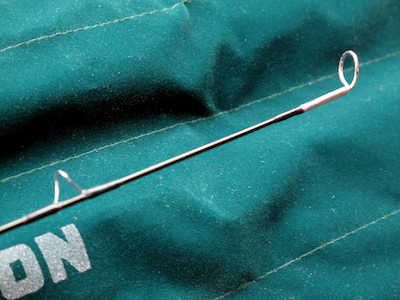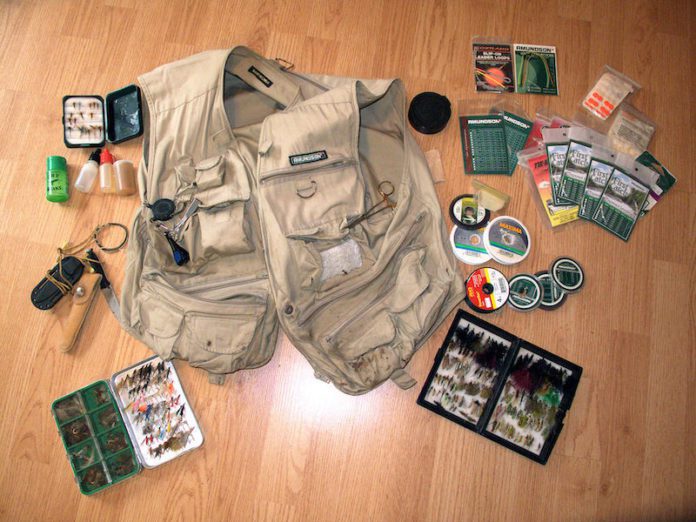September and October are coho months, but they’re trout months too, and I am often torn as to what to do on a given day. After that, though, winter sets in and since I don’t fly fish for winter steelhead (my rod eyelets and I both freeze); I can get bored and antsy waiting for spring. It’s time to tackle the annual chore of cleaning up, maintaining, and repairing my gear and flies.
For no particular reason, I always tackle my fly boxes and flies first.  I pull out my flies and check them over, making note of the torn up and rusty ones; I toss the wrecked ones away. Once my entire inventory is culled, I take the dry flies and steam the hackles to bring them back into shape. Setting them aside to dry, I then hit the tying bench and tie up the flies I just threw out.
I pull out my flies and check them over, making note of the torn up and rusty ones; I toss the wrecked ones away. Once my entire inventory is culled, I take the dry flies and steam the hackles to bring them back into shape. Setting them aside to dry, I then hit the tying bench and tie up the flies I just threw out.
After I get the flies all tied, I move on to the rest of the gear, starting with my reels. I separate the spools from their housings and inspect the parts for corrosion and rust, replacing anything seriously deteriorated. Then I take an old toothbrush and some gun solvent and scrub out all the moving parts. Once clean, I rinse the parts thoroughly and spray lightly with light oil. I touch up the heavy wear areas such as the spindle with a bit of white grease. A word of warning: do not get oil or grease on your lines—the petroleum in the lubricants can eat the vinyl.
Next I start in on my rods, which are the easiest to maintain. A quick rinse with a wet washcloth and a light application of car wax, and the finish comes back like new. I inspect each guide for frayed wraps or cracked epoxy, each handle for wear, pitted cork and excess dirt, and each reel seat to ensure it is still secure. If one or more of my rod handles are filthy, I put acetone (nail polish remover) on an old rag and wipe the handle down, which cleans the cork amazingly well. (Be careful, acetone literally melts vinyl and some rod finishes on contact.)
Then I move on to the real fun. Out comes my vest with all its trinkets and paraphernalia; I feel like a kid at Christmas when I do this. I go through each pocket, one at a time. This can take me most of the winter since every pocket is crammed with stuff. I examine the contents and take note of what I am short on, like leaders and tippets, and what needs replacing. Then I reorganize it to ensure the stuff gets put back in the right pocket.
Then it’s on to my lines, which also are easy to maintain. I strip them off the spools and stretch them, being careful not to overstretch and crack the finish. I give them a good washing with soap and warm water, then inspect them for damage or cracked finishes. I make note to replace badly cracked dry lines, and then treat the rest with a silicone cleaner/floatant. I store them in loose coils wrapped around a giant juice can or two-litre plastic pop bottle. Wet lines don’t need such close attention. A quick wipe with a wet cloth and a check for cracks, deep nicks, and cuts, and they’re done. I store all my lines in a closet.
Next come my waders. A quick once-over inspecting for cuts, tears, and excessive wear is all I find necessary. I repair any cuts or wear points with Aquaseal.
I always check my fin booties, fins, and wading boots as well. Every few years I know I will have to replace my fin heel straps; they always crack and finally tear just where they double over to go back through the buckle. Keep your eye on that; it’ll save you losing a fin at the wrong time. I wear booties on my feet inside my fins. They have a knob on the back of the heel that keeps my fins from slipping down, and they protect my wader feet from abrasions when I am walking around camp. I check the stitching and the glue points to make sure they are still holding together. I check my wading boots to make sure the felt soles are intact, and I re-glue or replace them as needed. I also test the quicklace eyelets for security.
My pontoon boat and belly boat get a once-over as well. Rusty oar clips and D-rings get a quick sanding with emery cloth and a light coat of oil. I look over my straps and anchor system to ensure everything is still secure and in good repair, then store them back in the loft.
I often notice along the way that I am in need of more gear. I find the offseason a great time to visit the various fishing and boating trade shows that run between January and April. These shows offer the chance to not only view all the new products on the market, but to actually try them out in the casting pools. There are often some pretty good sales to be had at these shows as well.
The outdoors shows also include some great seminars and lectures. Many well-known and knowledgeable experts give short seminars on subjects ranging from tying dry flies to nymphing creeks for trout and beach fishing for salmon. For those of you just starting out, these talks are absolutely invaluable, and are included in the price of admission.
Winter can be a frustrating time for me. Most of the lakes on Vancouver Island are iced over (but rarely thick enough to safely ice fish) and, while the rivers are open, most are running so fast that you almost need a 20-pound downrigger ball to get the fly to the bottom before the current rips it through the run. And, of course, there’s always the cold. Do yourselves a big favour, and use the offseason to take stock of your gear and clean it up. It passes the time, but more importantly you’ll be ready for spring and you won’t be caught unprepared. Your gear costs you a lot of money; a bit of maintenance and it should last you many years.






